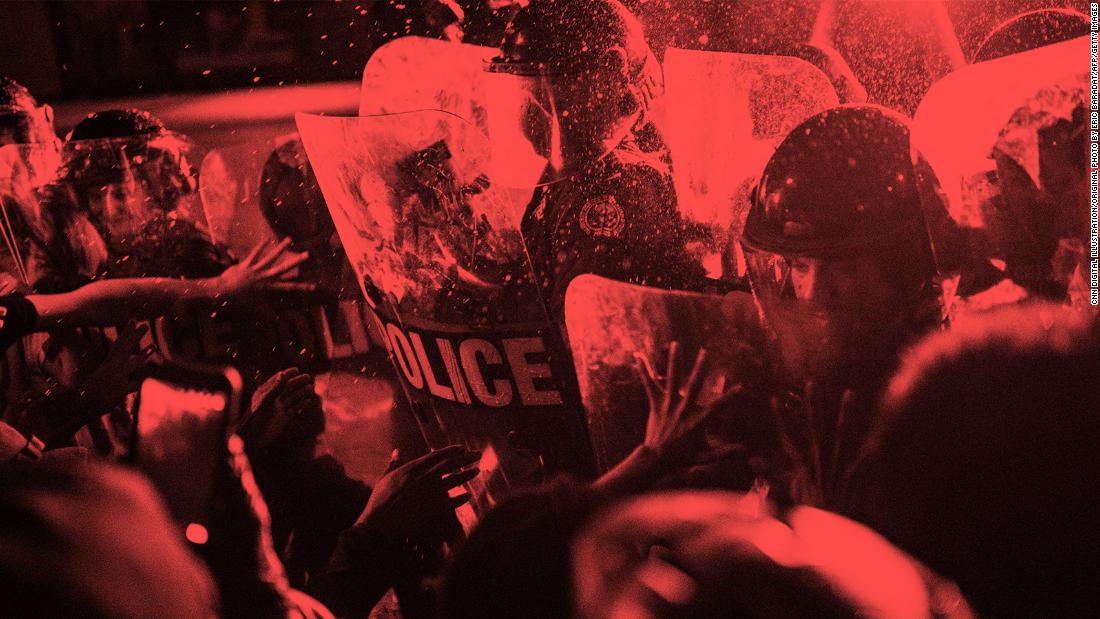Floyd was just one of the many Americans killed by police officers each year. But in other developed countries, such incidents are rare.
Statistical comparisons show that police in the US typically shoot, arrest and imprison more people than similarly developed nations.
Each nation listed below either accompanies the US in the G7 group of the world’s most advanced economies, or is ranked similarly on global wealth, freedom and democracy indexes. But when it comes to policing and criminal justice, the US is a noticeable outlier, and black Americans are disproportionately affected.
Data on arrests, deaths and prison populations do not exist uniformly across developed countries, so it can be difficult to pinpoint exactly how the US fares in comparison to every nation. For instance, it is impossible to know exactly how many people die at the hands of police officers in the US each year: no single, nationwide database that contains such information exists.
“We can’t have an informed discussion, because we don’t have data,” former FBI Director James Comey told the House Judiciary Committee in 2015. “People have data about who went to a movie last weekend … and I cannot tell you how many people were shot by police in the United States last month, last year, or anything about the demographics. And that’s a very bad place to be.”
We are therefore forced to rely on estimates — but even they paint a stark picture.
A
media review by the Bureau of Justice Statistics (BJS) found a total of 1,348 potential arrest-related deaths in the ten months from June 2015 through March 2016 — an average of 135 deaths per month, or just over 4 per day. (The review excludes deaths under the jurisdiction of federal and tribal law enforcement, and the BJS acknowledged it does not provide a complete picture.)
By comparison, only 13 people in the UK died in or following police custody in the closest time period, according to the country’s
police watchdog. In Australia, 21 deaths occurred in police custody or custody-related operations in 2015/16. Those measures are the most accurate comparison to the US’s figure of arrest-related deaths,
according to the UK Home Office. The UK’s figure does not include every death that occurred following police contact.
American police also shoot more people than forces in similarly developed countries.
The FBI
recorded that 407 people were shot in an act of “justifiable homicide” by a police officer in 2018, a decline on previous years. But homicides ruled justifiable do not capture every police killing, and the FBI’s numbers are derided by many human rights groups and news organizations which have collected far higher figures. The
Washington Post counted 1,004 people fatally shot by police in 2019, for instance, while the group
Mapping Police Violence tallied 1,099.
Comey’s comments to the House Judiciary Committee illustrate the FBI’s own acceptance that their number does not tell the full story. Nonetheless, even the FBI’s figure dramatically dwarfs that of many other countries, where police shootings are highly isolated incidents. And police in New Zealand and the UK (except Northern Ireland) do not routinely carry firearms.
Canada may most closely follow the US among G7 countries. Official data is only collected when an officer is charged, but an analysis by CNN affiliate
CBC found 461 fatal police encounters between 2000 and 2017.
Americans are also more likely to be arrested or jailed than their peers worldwide.
A total of 10,310,960 arrests were made in the US in 2018 — that’s one arrest made per every 32 American citizens. Those figures give the US a far higher arrest rate than the UK or Australia, among others.
Of those confronted or arrested by police, black Americans are more likely to be subjected to force — a key complaint of the protesters marching across the US.
Police officers are more likely to use force on black Americans — and,
according to a 2016 study published in the American Journal of Health, black men are nearly three times more likely than white men to be killed by police intervention. Comparable figures for other countries are not readily available.
In general, more Americans are subjected to the cogs of the criminal justice system than in many other countries; and more end up in prison, too.
The US has the largest prison population in the world, as well as the largest incarceration rate per capita, according to
World Prison Brief — a London-based initiative that counts inmate populations around the world annually.
Only four US cities have more inhabitants than the country’s prisons — and
America’s prison population of 2.2 million is higher than the combined
populations of Washington, DC, Boston and Miami.
Rates are high across the country. If every US state were counted as a country, the 31 countries with the highest incarceration rates in the world would all be US states, according to the
Prison Policy Initiative. Oklahoma, Louisiana and Mississippi all have incarceration rates of over 1,000, meaning more than one in a hundred people in those states were prisoners in 2018. By comparison, the highest incarceration rate outside the US is in El Salvador, where 614 people per 100,000 are prisoners, according to the Prison Policy Initiative.
Black Americans make up a third of the US prison population, despite only making up around an eighth of the country’s total population.
The UK and
Canada suffer similar issues, but not on the scale that the United States does.
The available data paints a clear and concerning picture — and explains why policing and justice reform have been rallying cries of protesters for so long.
CNN’s Sergio Hernandez contributed to this report.

